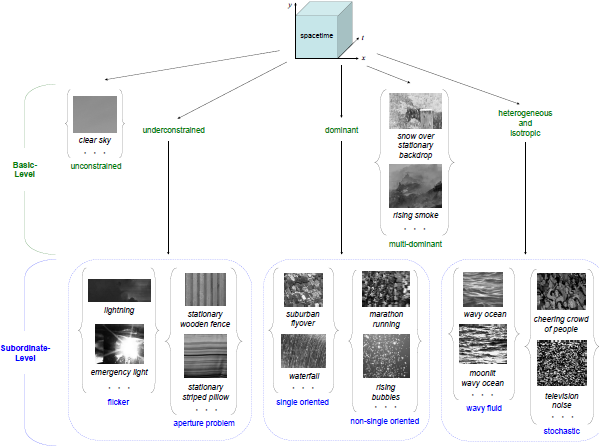Spacetime Texture Dataset
Konstantinos G. Derpanis and
Richard P. Wildes
Contact email kosta at cse dot yorku dot ca
Department of Computer Science and Engineering
and Centre for Vision Research
York University, Toronto, ON, Canada
Overview
This webpage provides a spacetime texture database.
The database contains a total of 610 spacetime texture samples. The videos were obtained
from various sources, including a Canon HF10
camcorder and the BBC Motion Gallery; the videos
vary widely in their resolution, temporal extents and
capture frame rates. Owing to the diversity within
and across the video sources, the videos generally
contain significant differences in scene appearance,
scale, illumination conditions and camera viewpoint.
Also, for the stochastic patterns, variations in the
underlying physical processes ensure large intra-class
variations.
For details of our technical approach to spacetime structure grouping, see our project page.
Database Organization
The figure below illustrates the overall organization of the York University Vision Lab (YUVL) spacetime texture database.

The data set is partitioned in two ways: (i) basiclevel
and (ii) subordinate-level, by analogy to terminology
for capturing the hierarchical nature of human
categorical perception [3]. The basic-level partition, is based on the
number of spacetime orientations present in a given
pattern; for a detailed description of these categories,
see Section 2.1 of [2]. For the multi-dominant category, samples
were limited to two superimposed structures
(e.g., rain over a stationary background). Note, the
basic-level partition is not arbitrary, it follows from the
systematic enumeration of dynamic patterns based
on their spacetime oriented structure presented in
Sec. 2.1 of [2]. Furthermore, each of these categories have
been central to research regarding the representation
of image-related dynamics, typically considered on a
case-by-case basis. To evaluate the ability
to make finer categorical distinctions, several of the
basic-level categories were further partitioned into
subordinate-levels. This partition
is based on the particular spacetime
orientations present in a given pattern. Beyond
the basic-level categorization of an unconstrained oriented
pattern (i.e., unstructured), no further subdivision
based on pattern dynamics is possible. Underconstrained
cases arise naturally as the aperture
problem and pure temporal variation (i.e., flicker).
Dominant oriented patterns can be distinguished by
whether there is a single orientation that describes
a pattern (e.g., motion) or a narrow range of spacetime
orientations distributed about a given orientation. Note
that further distinctions might be made based, for
example, on the velocity of motion (e.g., stationary
vs. rightward motion vs. leftward motion). In the
case of multi-dominant oriented patterns, the initial
choice of restricting patterns to two components to
populate the database precludes further meaningful
parsing. The heterogeneous and isotropic basic category
was partitioned into wavy fluid and those more
generally stochastic in nature. Further parsing within
the heterogeneous and isotropic basic-level category
is possible; however,
since this more granular partition
is considered in the UCLA data set [4], in the YUVL data
set only a two-way subdivision of the heterogeneous
and isotropic basic-level category is considered.
Download
Spacetime Texture Database (2.6GB download)
Related Papers
[1] K.G. Derpanis and R.P. Wildes, Dynamic Texture Recognition based on Distributions of Spacetime Oriented Structure, In Proceedings of the IEEE Conference Computer Vision and Pattern Recognition (CVPR), 2010.
[2] K.G. Derpanis and R.P. Wildes, Spacetime Texture Representation and Recognition Based on a Spatiotemporal Orientation Analysis, IEEE Transactions on Pattern Analysis and Machine Intelligence (PAMI), to appear.
[3] E. Rosch and C. Mervis, Family resemblances: Studies in the internal structure of categories. Cognitive Psychology, vol. 7, pp. 573-605, 1975.
[4] P. Saisan, G. Doretto, Y. Wu, and S. Soatto, Dynamic texture recognition, in CVPR, 2001, pp. II:58-63.
Last updated: October 6, 2011.
|



